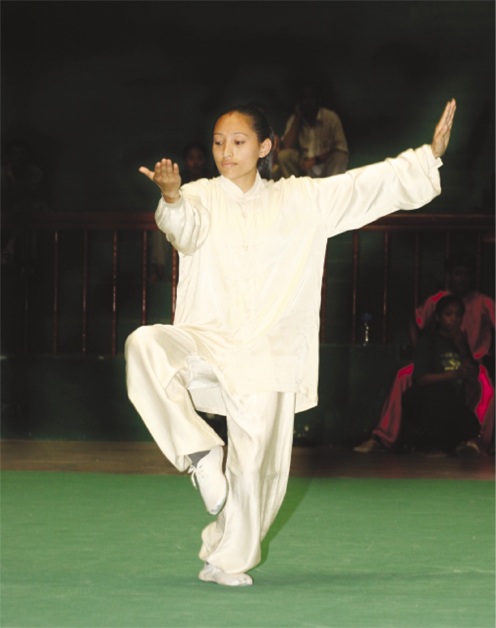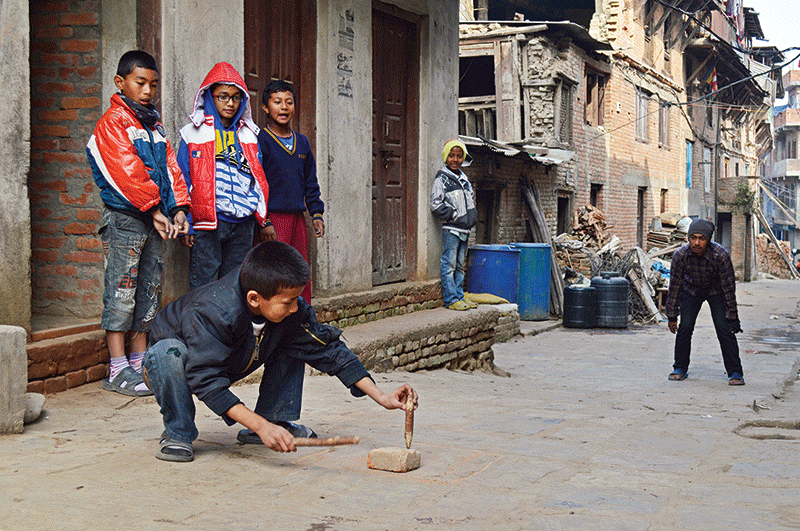“Qi Gong, Tai Chi and other yogic-type exercises all evoke a common state of the body, called the relaxation response. It raises metabolism, lowers the heart rate, blood pressure, rate of breathing, and slows brain waves. The belief is that when you’re in this state the body manifests an inborn, quiet energy that’s called qi” —Dr Herbert Benson (an excerpt from “You Gotto Have Qi” by Kate Drake)
 A refrain “The beautiful game” was heard over and over again cently held FIFA World Cup 2006
A refrain “The beautiful game” was heard over and over again cently held FIFA World Cup 2006
Championships. And indeed, it was further reinforced by the tremendous skills displayed by many of the players in so many of the games. Pele and millions of others are right, football is a beautiful game. But no less beautiful is another sport, one that is practiced by millions– young and old– almost every single day in almost every single country. This is the sport known as Tai Chi Quan (pronounced Thai Chi Chuan). Not only beautiful, Tai Chi is also one of the most graceful of all sports. And why shouldn’t it be? After all, the practice of Tai Chi is rooted in the philosophical aspects of that most ancient of philosophical thoughts – Taoism – a mystical Chinese tradition founded by Lao Tsu much ahead of even Confucius’ time. Taoism views the world as one that is steeped in beauty and tranquility and thus, advocates a serene, contemplative and spiritual approach. If so, Tai Chi cannot help but be beautiful. However, as everybody knows, Tai Chi being a martial art, is also more than just a sport. It is the most attractive art form of Wushu, the collective name for all Chinese martial arts.
Literally translated, Tai Chi Quan means ‘Supreme Ultimate Force”. The huge popularity of Tai Chi can be attributed to the fact that there are some for whom the art is interesting because of its combat aspects, most practitioners regard it as a meditative exercise. In eastern philosophy it is widely believed that ‘chi’ (also written as ‘Qi’) is a vital force within the body that invigorates health and can be harnessed with proper technique and exercise. One of Tai Chi’s primary goals is to do just that. Another aim is to cultivate serenity of the mind and this is achieved by focusing on precise movements during the routines. Tai Chi is also described as an ‘internal martial art’ which concentrates inner energies to lead movement instead of just acting and reacting.
Tai Chi Quan’s history is as old as China itself. Its origins have been traced back to about the year 1391, and its first proponent, Cheng Sen-feng, a monk of the Wu Tang monastery, is said to be the ‘founder’ of Tai Chi. It was Tang who created the ’13 postures’ which include eight ‘postures’ and five ‘attitudes’. The former consists of ward-off, rollback, press, push, pull, split, elbow strike and shoulder strike. The latter (‘attitudes’) include advance, retreat, look left, gaze right and central equilibrium. Later disciples such as Wang Chung-yueh and Chiang Fa elaborated on his theme and created the continuous movements leading gradually to the contemporary Tai Chi Quan form. In time, different practitioners developed newer styles of the art and consequently, we have six major forms of Tai Chi. They are: Chen style, Hao (Wu shi) style, Hu Lei style, Sun style, Wu style, and the most common, Yang style. Whatever the style, Tai Chi is said to be inspired by Taoism, the philosophy of which the sage, Lao Tsu, described in the 6th century BC, “Yield and overcome; Bend and be straight” and “He who stands on tiptoe is not steady; He who strides cannot maintain the pace.”
Lao Shi (Master) Pranil D. Karki is the founder and chief coach of Nepal Wushu Association which was established in 1986. Wushu is the name given to a host of different styles of Chinese martial arts among which, Tai Chi Quan is one of the most popular. However, according to the Lao Shi Karki, “All Chinese martial arts fall under the umbrella of Wushu and as a sport, all the different styles are equally important. Therefore, we do not lay too much emphasis on one over the other.” He’s right, especially since Wushu is being included for the first time in the Olympics as a demonstration sport and there are medals for the taking in all the styles in 2008.
Under the broad umbrella of Wushu falls Bare Hand Exercises, Long Weapon Exercises, Short Weapon Exercises and Sanshou. Under the first is included Taolo, of which Tai Chi Quan, Chang Quan (long range boxing) and Nan Quan (southern boxing) are the major styles. The Long Weapon Exercises include Gunshu (cudgel play), Quiangshu (spear play) and Nangun (southern cudgel). Short Weapon Exercises consist of Daoshu (broad sword play), Jianshu (sword play), Tai Chi Jian (sword play) and Nandao (southern broad sword).
Sanshou is a free combat form which involves kicks and punches as well as wrestling. Except for Sanshou, where there are various weight divisions between 48kg to over 90kg, there is no particular categorization according to weight in the other events. However, Lao Shi Karki is quick to point out, “Since most of the events are judged on speed, difficulty and presentation, it is preferable for practitioners to be between 5 and 6 feet tall because movements of the too short or the excessively tall can look ungainly. As for physique, you don’t have to look far. Bruce Lee is a good example!”
But of course, that is an ideal that few can attain and it is true that not all enthusiasts are planning to become champions. Also, obviously, most people are not too eager to be seen brandishing either cudgels or swords in their backyards. So, while Lao Shi Karki’s words hold water for many youngsters, it can be assumed that others, specially those past their prime, would like to practice less strenuous styles. This is where Tai Chi Quan comes in. There can be no doubt that it is one of the gentlest of martial arts and even the colours of the uniforms worn by Tai Chi practitioners prove the point. According to another Lao Shi, Roshan Budhathoki, a student of Pranil Karki, “The colours of Tai Chi uniforms are usually cream and pink – you know, gentle colours. The dress itself is also quite soberly styled with Chinese buttons and ankle length trousers.”
Unlike other martial arts, Wushu (and Tai Chi), do not award coloured belts to denote the proficiency of students. Rather, the dresses (Fuzhuangs) are different for the different styles although the training timetable is similar. For Nanquan events, sleeveless uniforms are worn while for Changquan, the dresses are quite colourful. Tai Chi of course, makes use of gentle colours in its uniforms. As for the training program, starting with a basic course of three months, the student goes on to the advanced basic category which is of six months. Then, it’s on to B+1 class for another nine months, and finally, the red belt class which takes a year of regular training. For those interested, there is also a diploma course lasting from one to three years depending upon performance. Tai Chi and Wushu as a sport have taken on much importance now. In 1990, Wushu first became a medal event in the Asian Games. Consequently, regular world championships have been held with participation from about 56 countries. This month (August) it is being held as a medal sport in the SAF Games for the first time in Sri Lanka as well as in the Asiads in December. As mentioned before, Wushu will be a demonstration game at the 2008 Summer Olympics in Beijing.
Explaining the training schedule, Lao Shi Pranil D. Karki says “A regular class lasts for two hours. It begins with 10 minutes of stretching followed by 15 minutes of jogging, a period of flexible kicking, 10-15 minutes of jumping, and finally, form exercises (Taolo) in which obviously, Tai Chi plays a major role.” Here, the master cannot stop himself from lamenting, “The competitions are so near at hand, yet there is no collaboration between members of the association and us, the trainers.” Pointing out the central guan (training hall), he says, “The facilities are the barest minimum.” Yet he is confident of bringing home at least 8- 10 medals for the country. This speaks volumes about the dedication of the Lao Shis as well as of their students.
And perhaps, it’s just as well, because Wushu needs massive doses of discipline and dedication for any student to be proficient. More so in the case of Tai Chi, where patience is another primary requisite. Generally, the practice of Tai Chi entails very slow movements although in situations requiring one to defend oneself, Tai Chi can be performed very fast and explosively. However, the essence of Tai Chi is that, by practicing slow and precise movements regularly, one develops inner peace and tranquility which assists in slowing down situations in one’s mind. Thus, the practitioner is in a position to analyze clearly, the physical data around him. Besides this, the slow movements of Tai Chi allows one to improve one’s stances through self analysis, improve one’s postures and enhance efficiency by doing away with unwanted movements. In addition, unlike other martial arts where fast movements constrict blood flow to the brain, thereby making it impossible to be meditative while practicing, Tai Chi practice is a good way of developing a meditative state. This is because Tai Chi Quan keeps the heart rate even and the blood flow, balanced, even in situations of stress.
Although we are used to seeing images of elderly people in parks practicing the art, in its original form, Tai Chi is a fighting art and its techniques for combat are quite scientific. And although Tai Chi forms call for individual aptitude, the foundations of its combative aspects lie in an exercise called ‘pushing hands’. With this, the Tai Chi practitioner first comes into contact with another practitioner and the exercise allows both to test and analyze each one’s weaknesses as well as strengths. ‘Push Hands’, as it progresses, develops into a sparring martial arts like exercise. Tai Chi forms themselves are divided according to different number of movements but for competitive purposes, mainly the 42 forms are most popular. The ‘long’ form of Tai Chi Quan is the most traditional and consists of 108 movements that progresses in length and difficulty through three stages. ‘Long’ or ‘short’, these forms develop the basic principles of Tai Chi, i.e. centeredness, balance, internal tranquility, rhythm, and preciseness. In the process, realizing the goal of Tai Chi Quan - ‘to subdue the vigorous by the soft’.
Many students have passed out from the tutelage of Lao Shi Pranil D. Karki, and have established their own training centers. Some of the recent Tai Chi centers are said to be affiliated to Taiwan unlike the main central body which has its base in mainland China. According to another Lao Shi, Suman Bhatta, “The Nepal Wushu Association has 25 Lao Shis (trainers).” Today at least 1,500 regular students in over 25 districts of Nepal are following the footsteps of Cheng Sen-feng, and in Kathmandu alone, there are more than 250 practitioners in its central guan (training center).
Note: Some spellings of Chinese names may be inaccurate. It should also be noted (according to Lao Shi Pranil D Karki) that in Chinese, ‘T’ is pronounced as ‘Th’ so Tai Chi is pronounced, ‘Thai Chi’ and Taolu is pronounced as ‘Thaolu’. Similarly, ‘G’ is pronounced as ‘K’ so Guan becomes ‘Kuan’. ‘Q’ is pronounced as ‘Ch’ so Quan becomes, ‘Chuan’.










